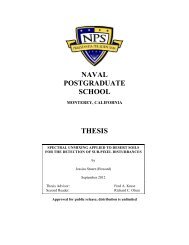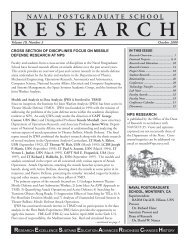Information Technology Management - Naval Postgraduate School
Information Technology Management - Naval Postgraduate School
Information Technology Management - Naval Postgraduate School
You also want an ePaper? Increase the reach of your titles
YUMPU automatically turns print PDFs into web optimized ePapers that Google loves.
MASTER OF SCIENCE IN INFORMATION TECHNOLOGY MANAGEMENT<br />
MILITARY APPLICATIONS OF INTRANET TECHNOLOGY: FLEET<br />
NUMERICAL METEOROLOGY AND OCEANOGRAPHY CENTER<br />
Charles W. Booth-Commander, United States Navy<br />
B.S., United States <strong>Naval</strong> Academy, 1980<br />
Master of Science in <strong>Information</strong> <strong>Technology</strong> <strong>Management</strong>-September 1997<br />
and<br />
Barbara J. Gutsch-Lieutenant, United States Navy<br />
B.S., Arizona State University, 1984<br />
M.B.A., New Hampshire College, 1989<br />
Master of Science in <strong>Information</strong> <strong>Technology</strong> <strong>Management</strong>-September 1997<br />
Advisors: James C. Emery, Department of Systems <strong>Management</strong><br />
Frank J. Barrett, Department of Systems <strong>Management</strong><br />
Intranets are rapidly becoming a corporate internal information-sharing medium. Intranet technology is the same robust,<br />
proven, industry standard technology that is used on the Internet. The technical aspects of implementing the technology are<br />
simple. The organization and management aspects are significant and are key to its successful implementation. This internal<br />
use of Internet technology is easy, inexpensive, and has produced savings and benefits for corporate organizations.<br />
This thesis reviews corporate and government intranets and examines the feasibility of implementing this technology<br />
and benefiting from it, in a military organization. Specific applicability of intranet technology was examined at Fleet<br />
Numerical Oceanographic and Meteorology Center, while maintaining the vision of its applicability to other military organizations.<br />
Fleet Numerical Oceanographic and Meteorology Center has the requisite technical and organizational infrastructure<br />
necessary to successfully implement intranet technology. The management and technical skill sets necessary to<br />
successfully implement this technology at any military command operating a computer network should be available, or<br />
easily trained. Fleet Numerical Oceanographic and Meteorology Center and the U.S. Military should establish the organizational<br />
plans and infrastructure to implement and exploit this empowering information sharing medium.<br />
APPLYING TECHNOLOGY TO MARINE CORPS DISTANCE LEARNING<br />
Michael G. Broihier-Major, United States Marine Corps<br />
B.A., Rutgers College, 1984<br />
Master of Science in <strong>Information</strong> <strong>Technology</strong> <strong>Management</strong>-September 1997<br />
Advisors: Alice M. Crawford, Department of Systems <strong>Management</strong><br />
Hemant Bhargava, Department of Systems <strong>Management</strong><br />
The purpose of this thesis is to investigate the application of technology to distance learning with the intention of recommending<br />
to the Marine Corps a feasible migration path away from its current correspondence program. Currently, the<br />
Marine Corps Institute (MCI) administers correspondence courses for both Occupational Skill Development (OSD) and<br />
Professional Military Education (PME). Automating and streamlining MCI processes is insufficient considering the pivotal<br />
importance distance learning plays in a Marine’s career. Current application of technology to distance learning in education,<br />
business, and the military is discussed in light of information obtained through interviews, site visits, conferences, and the<br />
literature. A non-exhaustive list of tangible and intangible costs and benefits related to various distance learning technologies<br />
is provided, as well as a template for a distance learning decision making -process. The process can be used with<br />
decision support software to match requirements to technology and select appropriate migration paths through cost benefit<br />
analysis. This thesis recommends applying asynchronous methods to OSD courses and a combination of synchronous and<br />
asynchronous methods to PME courses. Finally, this thesis recommends changing the current structure and mission of MCI<br />
and consolidating its efforts with the College of Continuing Education under the Marine Corps University.<br />
106
















